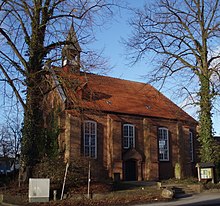St. Mary's Church, Himmelpforten
| St. Mary's Church | |
|---|---|
|
|

St. Mary's Church, southern façade seen from the Main Street
|
|
| 53°36′52″N 09°18′17″E / 53.61444°N 9.30472°ECoordinates: 53°36′52″N 09°18′17″E / 53.61444°N 9.30472°E | |
| Location | Himmelpforten |
| Country | Germany |
| Denomination | Lutheran |
| Website | www |
| History | |
| Former name(s) | Dreifaltigkeitskirche (Trinity Church) |
| Dedication | St. Mary |
| Architecture | |
| Status | Parish church |
| Functional status | Active |
| Architect(s) |
|
| Architectural type |
aisleless church quire oriented |
| Groundbreaking | 1737 |
| Completed | 1738 |
| Specifications | |
| Length | 23.5 m (77 ft) |
| Width | 11.75 m (38.5 ft) |
| Materials | Brick |
| Administration | |
| Parish | Himmelpforten |
| Deanery | Stade deanery |
| Diocese | Stade diocese |
| Synod | Church of Hanover |
| Clergy | |
| Senior pastor(s) | Rainer Klemme |
| Pastor(s) | Christian Plitzko |
The Saint Mary's Church (Low German: Sünt Marienkark, German: Sankt Marienkirche) is a Lutheran parish church used and owned by the Lutheran parish in Himmelpforten, Lower Saxony, Germany. The Himmelpforten parish forms part of the Stade deanery (Kirchenkreis) within the Stade diocese of the Lutheran Church of Hanover. The church was completed in 1738 and covers the eastern half of the foundations of the demolished abbey church of the former Himmelpforten Convent.
Today's church was erected in 1738 using rests of the former abbey church which had mostly been torn down due to dilapidation in 1737. The previous Cistercian church building was the abbey of the former Conventus Porta Coeli, in 1255 relocated to Himmelpforten on the instigation of the Prince-Archbishop of Bremen. From the beginning on the abbey church served also as the parish church of the local parish (Kirchspiel Himmelpforten).
Noble families from the Elbe–Weser triangle (Bremian ministerialis) bestowed land and dues on the Cistercian nunnery, enabling it to sustain their unmarried kinswomen. The nuns, and later the Lutheran conventuals (after the Reformation), elected a provost as their legal male representative to the outside. The provost was entitled to nominate the candidates (ius nominandi) to be appointed as pastors in the parishes of Großenwörden, Himmelpforten, and Horst upon Oste.
...
Wikipedia

